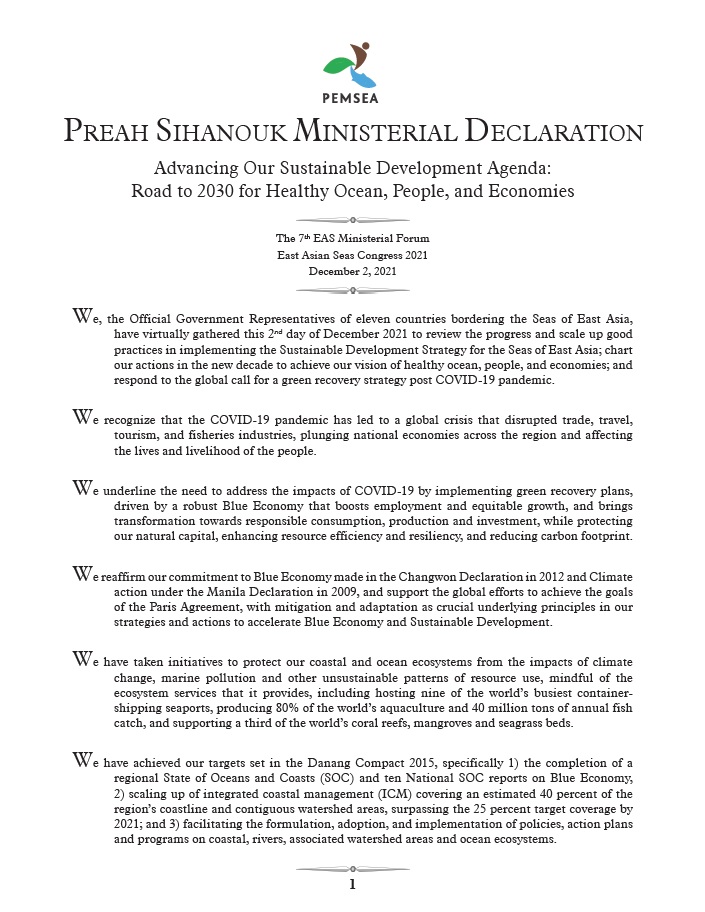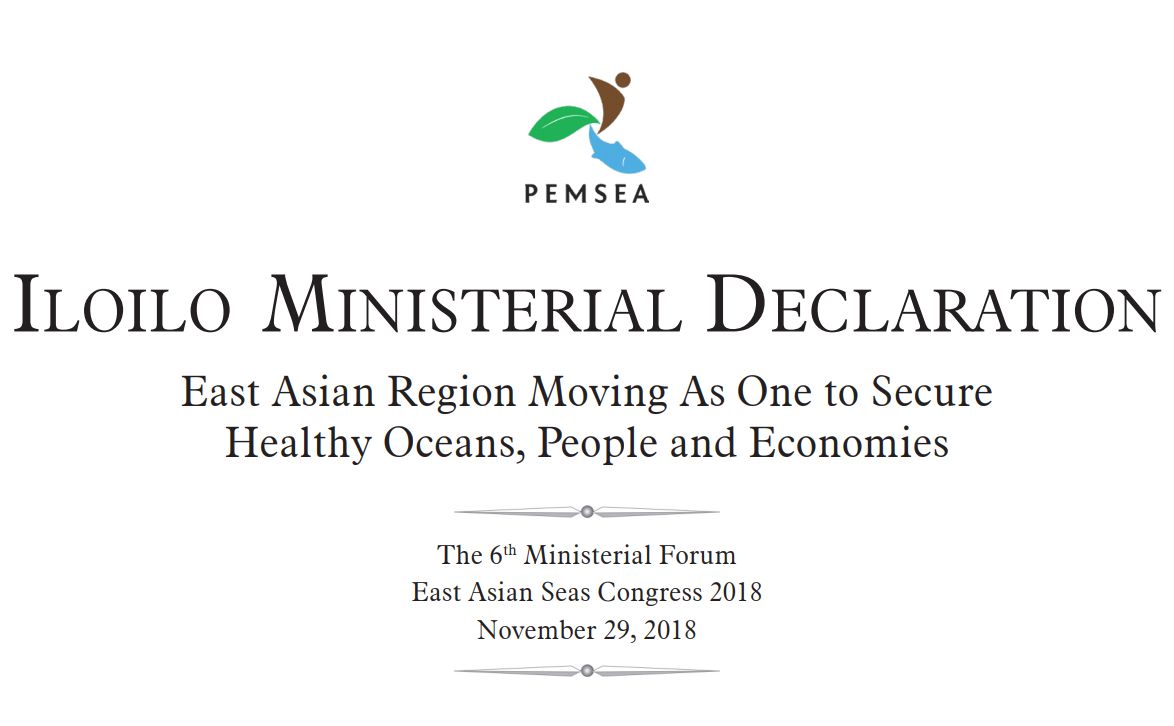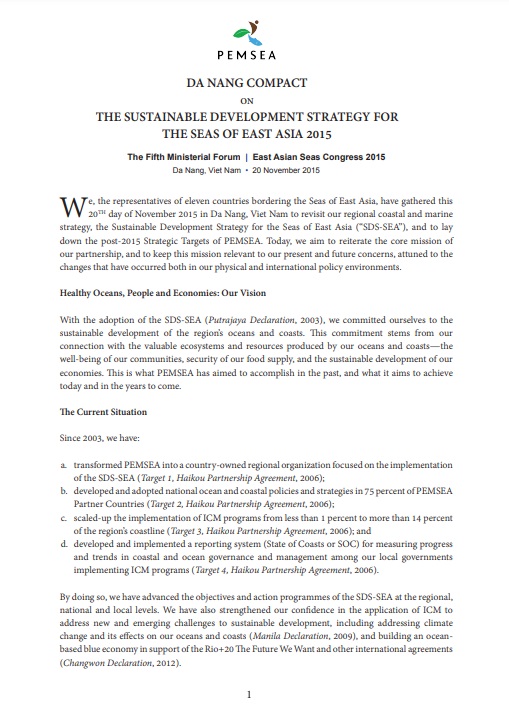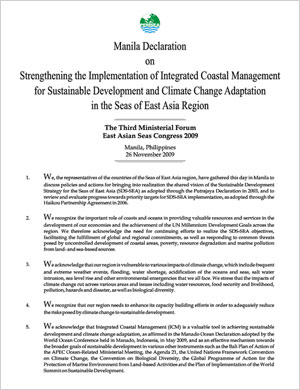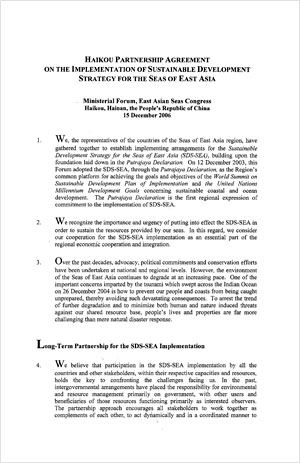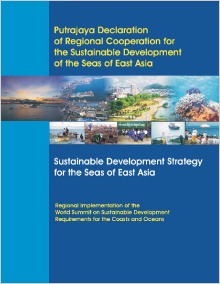
Breadcrumb
-
Preah Sihanouk Ministerial Declaration
The Preah Sihanouk Ministerial Declaration was signed by senior government officials of PEMSEA’s country partners. One integral part of this Declaration is the endorsement of the formulation of the PEMSEA Roadmap to 2030, which aims to combine the values, principles, and key achievements that were carefully cultivated and replicated through years of transforming the EAS Partnership from a regional marine pollution project into a leading regional collaborative mechanism and the available opportunities that will enable the Partnership to maintain its relevance and fit for purpose in the region.
-
Iloilo Ministerial Declaration
The Iloilo Ministerial Declaration was signed by Ministers from PEMSEA country partners on 29 November 2018 during the Sixth Ministerial Forum, part of the Sixth East Asian Seas Congress.
-
Da Nang Compact on the Sustainable Development Strategy for the Seas of East Asia 2015
Signed during the Fifth Ministerial Forum on the Sustainable Development Strategy for the Seas of East Asia on 20 November 2015, the Da Nang Compact revisits and reaffirms the regional coastal and marine strategy, the Sustainable Development Strategy for the Seas of East Asia (SDS-SEA), and lays down the post-2015 Strategic Targets of PEMSEA.
Ministers and head of delegations from 11 countries of the East Asian Seas (EAS) signed the Compact. The Compact is the region’s support for the United Nations Sustainable Development Goals (SDGs) and other relevant international and regional commitments related to coasts and oceans.
With the signing, Ministers and head of delegations from Cambodia, PR China, DPR Korea, Indonesia, Japan, Lao PDR, the Philippines, RO Korea, Singapore, Timor-Leste, and Viet Nam adopted the SDS-SEA 2015. The SDS-SEA 2015, is an updated version of the SDS-SEA 2003, which incorporates strategies, objectives and action programmes for climate change adaptation, disaster risk reduction, and conservation of marine and coastal biodiversity, among others. The SDS-SEA 2015 was adopted as a common platform for regional cooperation, and as a framework for policy and programme development and implementation, at the national and local level.
The Compact aimed to reiterate the core mission of the partnership and keep the mission relevant to present and future concerns, attuned to the changes that have occurred both in our physical and international policy environments. Through the Da Nang Compact, the 11 countries of the PEMSEA committed to achieve medium-term targets as set forth in the Post-2015 Strategic Targets of PEMSEA:
TARGET 1: By 2017, a self-sustaining PEMSEA Resource Facility managing and coordinating a suite of products, services and financing mechanisms for advancing SDS-SEA implementation at the regional, national and local levels.
TARGET 2: By 2018, a regional State of Oceans and Coasts reporting system to monitor progress, impacts and benefits, and to continually improve planning and management of SDS-SEA implementation.
TARGET 3: By 2021, national coastal and ocean policies, and supporting legislation and institutional arrangements set up and functional in 100% of PEMSEA Partner Countries, consistent with international environmental and sustainable development commitments and based on best available scientific information.
TARGET 4: By 2021, ICM programs for sustainable development of coastal and marine areas covering at least 25% of the region’s coastline and contiguous watershed areas, supporting national priorities and commitments under the UN SDGs, UNFCCC, Aichi Biodiversity Targets, UNISDR Post-2015 Framework for Disaster Risk Reduction, and other relevant environmental and sustainable development targets subscribed to by PEMSEA Partner Countries.
The SDS-SEA 2015 will be guiding documents for the work of the countries of EAS region in the journey of achieving the targets. PEMSEA will monitor the progress and achievements of the Da Nang Compact using the regional and local State of the Coasts reporting system.
-
Manila Declaration on Strengthening the Implementation of the Integrated Coastal Management for Sustainable Development and Climate Change Adaptation in the Seas of East Asia Region
Signed by the ministers of 11 countries during the Third Ministerial Forum in Manila on 26 November 2009, the Manila Declaration on Strengthening the Implementation of the Integrated Coastal Management for Sustainable Development and Climate Change Adaptation in the Seas of East Asia Region (Manila Declaration) acknowledges the need for continuing efforts to realize the SDS-SEA objectives, facilitating the fulfillment of global and regional commitments, as well as responding to common threats posed by uncontrolled development of coastal areas, poverty, resource degradation and marine pollution from land- and sea-based sources. The declaration also calls on PEMSEA, as the regional mechanism for the implementation of the SDS-SEA, to undertake the development of the Implementation Plan for the SDS-SEA in 2010 for consideration by countries, to facilitate the scaling up of ICM programmed in countries across the region and to promote regional cooperation in education and training activities related to ICM and climate change adaptation, taking into account the Haikou Partnership Agreement.
-
Haikou Partnership Agreement on the Implementation of Sustainable Development Strategy for the Seas of East Asia
The Haikou Partnership Agreement was signed among 11 countries, thereby formally establishing PEMSEA as the regional coordinating mechanism for the implementation of the SDS-SEA. The Agreement also confirmed the countries’ resolve to transform PEMSEA from a regional project-based arrangement to a self-sustained and effective regional collaborative mechanism with a mandate to pursue the implementation of the SDS-SEA through collaborative, synergistic and responsible actions. The digital file includes the Partnership Operating Arrangements for the Implementation of the Sustainable Development Strategy for the Seas of East Asia as an attachment.
-
Putrajaya Declaration of Regional Cooperation for the Sustainable Development of the Seas of East Asia
On 12 December 2003, at the Ministerial Forum during the East Asian Seas Congress 2003, concerned ministers of PEMSEA participating countries, as well as representatives of other stakeholder entities, adopted the Putrajaya Declaration of Regional Cooperation for the Sustainable Development of the Seas of East Asia. By adopting the SDS-SEA, the Putrajaya Declaration conveys a regional policy commitment to sustainable development of the seas of East Asia and to forge stakeholder partnership arrangements in addressing areas of concern.
The SDS-SEA provides a regional implementing framework and strategies for achieving the goals of key international agreements and action plans including the UN Millennium Development Goals, the World Summit on Sustainable Development Plan of Implementation, Chapter 17 of Agenda 21 and other international instruments related to coasts, islands and oceans. The SDS-SEA was developed after three years of extensive consultations with the 12 participating governments and 16 stakeholder partners, and embodies a shared vision among stakeholders towards achieving the sustainable use of coastal and marine natural resources, protection of the ecosystems, protection of life and property of the coastal population and sustaining the benefits provided by marine ecosystems. Action programs are developed under six major strategies: Sustain, Preserve, Protect, Develop, Implement and Communicate. On 12 December 2003, at the Ministerial Forum during the East Asian Seas Congress 2003, concerned ministers of PEMSEA participating countries, as well as representatives of other stakeholder entities, adopted the Putrajaya Declaration of Regional Cooperation for the Sustainable Development of the Seas of East Asia. By adopting the SDS-SEA, the Putrajaya Declaration conveys a regional policy commitment to sustainable development of the seas of East Asia and to forge stakeholder partnership arrangements in addressing areas of concern.
